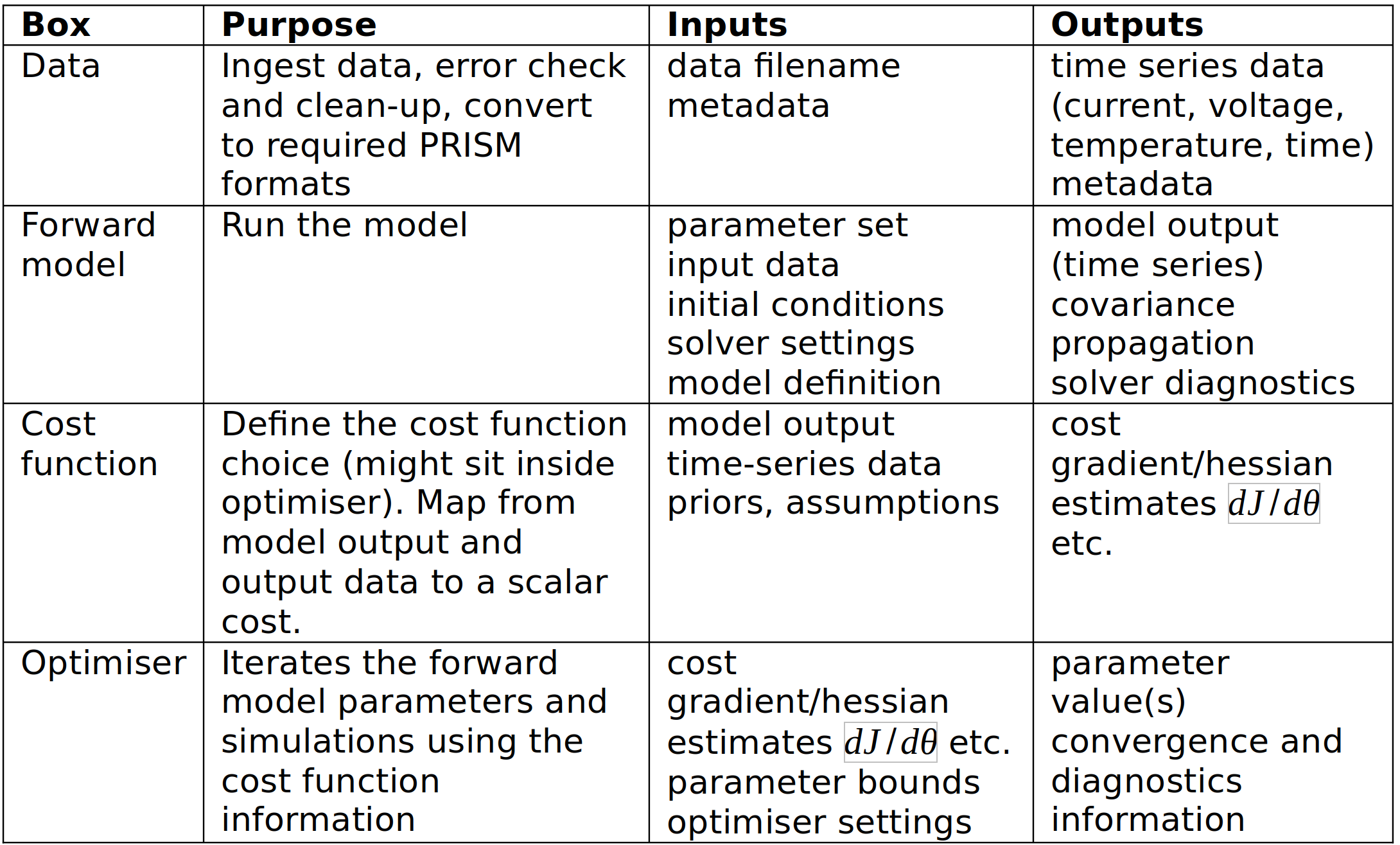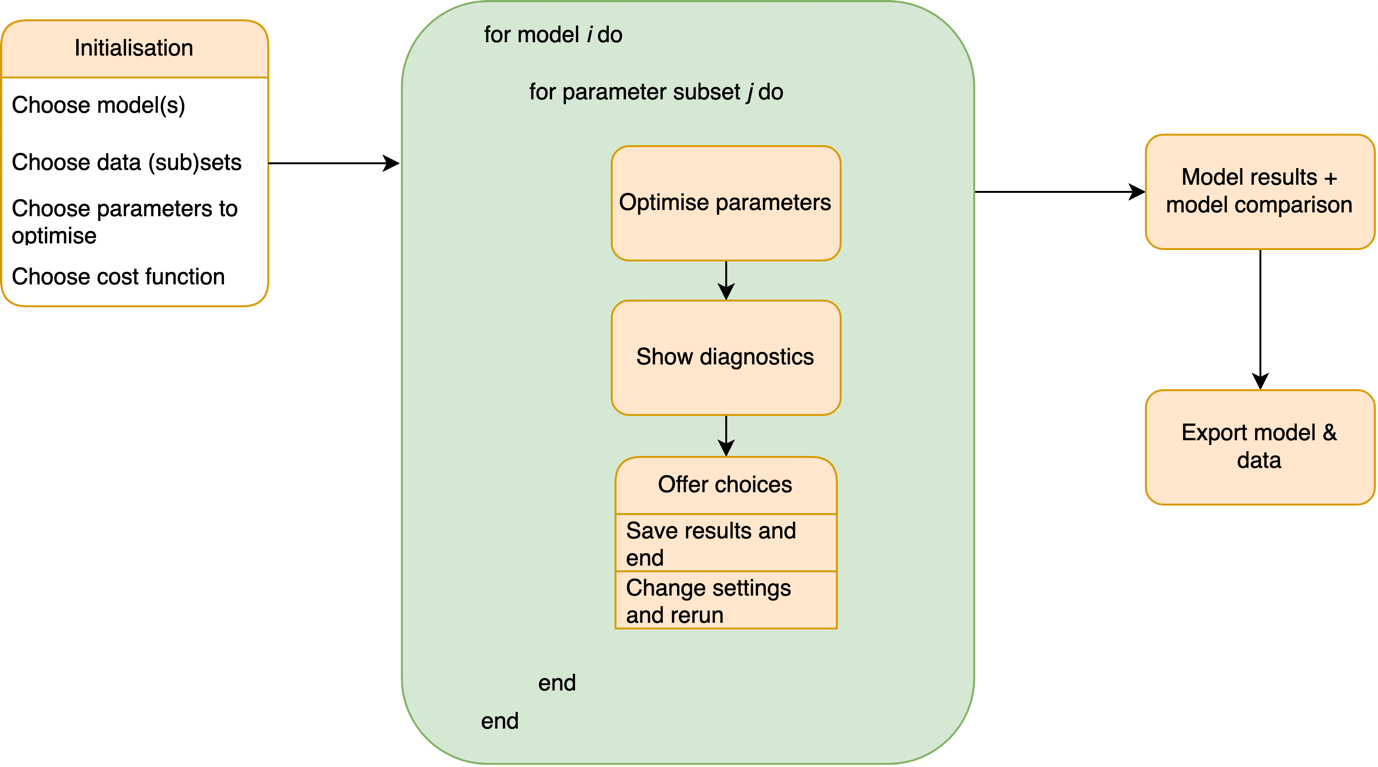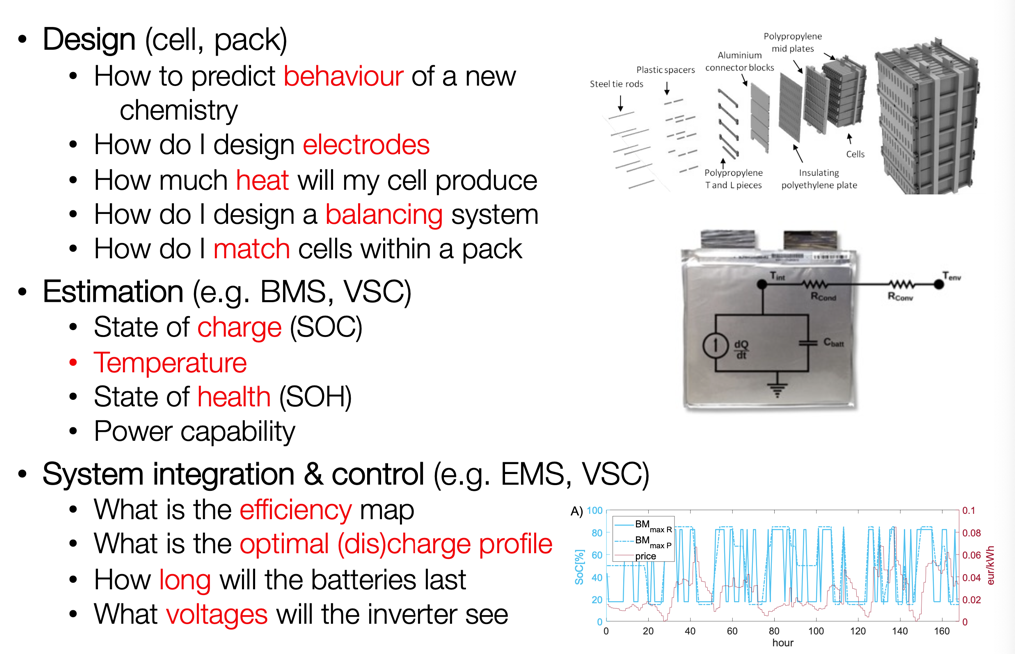PyBOP -- A new toolbox for parameterising battery models
Faraday Institution Multiscale Modelling Project + EU 'Intelligent' Project
David Howey, Brady Planden, add others in due course
22nd June 2023 (following a workshop on 7th June)
Overall objective
PyBOP will be a new open-source software library for parameterising battery models.
Motivation
Battery models are complex and involve many parameters (e.g., resistances/capacitances, diffusion timescales, etc.). Whilst some parameters might be obtained from first principles (e.g., via atomistic simulations or similar), in general, battery models must be parameterised from experimental measurements. This is challenging because:
-
It's not clear whether the parameters are unique (in principle or in practice).
-
Users may not be experts in the field of system identification and modelling but might still wish to know whether their models are fit for purpose.
-
It's not always obvious what excitation signals should be used to gather test data, and what techniques and workflows should be used to parameterise models.
-
Battery models are used over wide temperature and C-rates and the model parameters need to be estimated accordingly.
Academic and scientific novelty
Although there has been a large amount of research on battery model parameterisation, and system identification in general, it remains a relatively uncharted area due to the complexity of battery materials and devices. Current research on this tends to be disjointed, with individual groups continually reinventing the wheel when it comes to parameterisation methods. System identification of models has a long history in control engineering, and well-established toolboxes exist for generic model fitting e.g. the SysID toolbox in Matlab. However, these tend to work best on simple linear time-invariant systems, whereas battery models may involve non-stationary and non-linear behaviours, as well as PDEs and algebraic constraints.
Audience
The first end-users for PyBOP will be the MSM and 'intelligent' project teams and PyBOP developers -- if it isn't useful for us, then it won't be useful for others!
Community and values
We aim to build a broad consortium to develop PyBOP, building on and learning from the success of the PyBaMM community. Our values are:
-
Openness (e.g., code is open source on GitHub)
-
Inclusivity and fairness (those who want to contribute may do so, and their input is appropriately recognised)
-
Inter-operability (aiming for modularity to enable maximum impact and inclusivity)
-
User-friendliness (putting user requirements first, thinking about handholding & workflows)
What PyBOP will do
A list of some use cases for battery modelling is given in Appendix A. From this, we deduce that the two key requirements for PyBOP are:
-
Parameter estimation of battery models (could be electrochemical or equivalent circuit) -- to be used for e.g. pack design purposes, BMS design, and aging data analysis.
-
Design optimisation studies, e.g., layer thickness, number of layers, tab placement.
-
A tertiary requirement for PyBOP might be model synthesis, i.e., generating (low order) models automatically from data or higher order, more complex models. This is not in the scope of PyBOP at this stage, though.
A more detailed breakdown of all requirements is given below.
Software requirements specification
Essential requirements are marked **; other requirements are longer-term (i.e., desirable but not essential for a first release).
-
Parameterisation
A. Two major use cases: design optimisation and parameter estimation **
B. Cost functions can be built-in or user-defined
C. Multiple options for simulation and optimisation are offered and could include deterministic or probabilistic approaches **
-
User experience
A. Self-diagnosis of performance, e.g., able to quantify the goodness of fit, identifiability etc. **
B. Clear and understandable diagnostic outputs for users **
C. Easy to use for a non-expert user (leads to workflows, examples) [e.g. basic results are possible after just 1 hour of training]
D. Flexible data ingestion (e.g. pull from CSV, a database, or parquet, via JSON metadata specification) **
-
Performance
A. Quick (but possibly sub-optimal) results in a short time [<1 min], more accurate results in a longer-term [<1 hour]
B. Different levels of computational complexity are possible but mostly geared towards desktop solutions (i.e., not requiring a cluster)
-
Software design
A. Modular approach, with clearly specified interfaces between sub-components **
B. High code reusability. Within reason, don't reinvent the wheel -- use existing tools as much as possible **
C. Professional software engineering development practices (e.g. CI from the beginning) **
D. Close integration with PyBaMM for battery simulations (some user understanding of PyBaMM may be required) **
E. Cross-platform, able to run on Windows, Mac OS, Linux **
F. Python-based (Julia could be explored later as a secondary objective) **
G. Command-line interface/notebook-based (rather than GUI -- although this could come later) **
-
Clear, documentation with plenty of examples
How PyBOP will work
PyBOP will be a modular library for the parameterisation and optimisation of battery models, with a particular focus on classes built around PyBaMM models and structures. The figure below gives a conceptual idea of how PyBOP could be structured. An explanation of each box is given below the diagram. This will likely evolve as development progresses (e.g., in practice, some things will live "inside" other things in a more nested way), so this is just a starting point.
Figure 1: PyBOP architecture showcasing multiple forward models and cost functions
The modules in the above figure are defined as:
Workflow
From a user perspective, the tool would typically be used as described below. The reason for having the parameters/data divided into subsets is that this is likely to be important for making parameter estimation tractable. For example in a battery model a typical flow would be to first fit thermal properties, then fit OCV data, then fit dynamic electrical/electrochemical parameters.
Open questions
-
We're going to be handling much data. How will we handle it? Pandas data frame? Some database? Integrated or not with PyBaMM?
-
What needs to be done to integrate PEM (or MAP etc.) into Casadi or Scipy.optimize?
-
What are the minimal requirements for the PyBaMM model class? [1] [2]
-
What are the large probabilistic/optimisation libraries in Python? [1] [2] [3] [4] [5] [6]
-
What is the best way to interface with Galv:
-
API definition between Galv ↔ PyBOP ↔ PyBaMM
-
Automated parameterisation in Galv via PyBOP
-
Enabling automated digital twin predictions
-
Next actions
-
Circulate this document to those who came to the PyBOP workshop for comments and edits.
-
Then circulate to the wider MSM team.
-
Then agree/bank the contents for now.
-
Create a couple of benchmark datasets and simple models for examples.
-
Discuss possible merging of some of the existing codebase from pybamm-param into PyBOP.
-
Could we identify a few example cases and collate the minimum parameterisation and validation data-sets required (for those examples) in a common place? For example, we can share OCV, HPPC, rate-tests and drive cycles (done at different temperatures) which can them be used to develop the work flow in Figure 1 and estimate and validate either an ECM or EHTM type model? To basically identify a few examples and serval data sets (from different MSM groups) in a common place to start building the workflow of Figure 1. Will also help in addressing the first bullet point in Open Question.
APPENDIX A -- Battery modelling use cases
Here are some reasons why battery modelling matters. There are more! This is just a starting point.
[1]: Attendees: David Howey, Brady Planden, Ferran Brosa Planella, Monica Marinescu, Alistair Hales, Martin Robinson, Masaki Adachi, Nicola Courtier, Jon Chapman and Dhammika Widanalage



